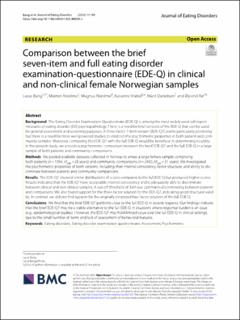| dc.contributor.author | Bang, Lasse | |
| dc.contributor.author | Nordmo, Morten | |
| dc.contributor.author | Nordmo, Magnus | |
| dc.contributor.author | Vrabel, KariAnne | |
| dc.contributor.author | Danielsen, Marit | |
| dc.contributor.author | Rø, Øyvind | |
| dc.date.accessioned | 2023-12-18T13:45:19Z | |
| dc.date.available | 2023-12-18T13:45:19Z | |
| dc.date.created | 2023-11-23T12:17:12Z | |
| dc.date.issued | 2023 | |
| dc.identifier.citation | Journal of Eating Disorders. 2023, 11 (1), . | en_US |
| dc.identifier.issn | 2050-2974 | |
| dc.identifier.uri | https://hdl.handle.net/11250/3108047 | |
| dc.description.abstract | Background
The Eating Disorder Examination-Questionnaire (EDE-Q) is among the most widely used self-report measures of eating disorder (ED) psychopathology. There is a need for brief versions of the EDE-Q that can be used for general assessment and screening purposes. A three-factor 7-item version (EDE-Q7) seems particularly promising but there is a need for more well-powered studies to establish the psychometric properties in both patient and community samples. Moreover, comparing the EDE-Q7 with the full EDE-Q would be beneficial in determining its utility. In the present study, we provide a psychometric comparison between the brief EDE-Q7 and the full EDE-Q in a large sample of both patients and community comparisons.
Methods
We pooled available datasets collected in Norway to amass a large female sample comprising both patients (n = 1954, Mage = 28 years) and community comparisons (n = 2430, Mage = 31 years). We investigated the psychometric properties of both versions, including their internal consistency, factor structure, and ability to discriminate between patients and community comparisons.
Results
The EDE-Q7 showed similar distributions of scores compared to the full EDE-Q but produced higher scores. Results indicated that the EDE-Q7 have acceptable internal consistency and is adequately able to discriminate between clinical and non-clinical samples. A cut-off threshold of 3.64 was optimal in discriminating between patients and comparisons. We also found support for the three-factor solution for the EDE-Q7, indicating good structural validity. In contrast, we did not find support for the originally proposed four-factor solution of the full EDE-Q.
Conclusions
We find that the brief EDE-Q7 performs close to the full EDE-Q in several respects. Our findings indicate that the brief EDE-Q7 may be a viable alternative to the full EDE-Q in situations where response burden is an issue (e.g., epidemiological studies). However, the EDE-Q7 may hold limited value over the full EDE-Q in clinical settings, due to the small number of items and lack of assessment of behavioral features. | en_US |
| dc.language.iso | eng | en_US |
| dc.publisher | BMC | en_US |
| dc.rights | Navngivelse 4.0 Internasjonal | * |
| dc.rights.uri | http://creativecommons.org/licenses/by/4.0/deed.no | * |
| dc.title | Comparison between the brief seven-item and full eating disorder examination-questionnaire (EDE-Q) in clinical and non-clinical female Norwegian samples | en_US |
| dc.title.alternative | Comparison between the brief seven-item and full eating disorder examination-questionnaire (EDE-Q) in clinical and non-clinical female Norwegian samples | en_US |
| dc.type | Journal article | en_US |
| dc.type | Peer reviewed | en_US |
| dc.description.version | publishedVersion | en_US |
| dc.source.pagenumber | 12 | en_US |
| dc.source.volume | 11 | en_US |
| dc.source.journal | Journal of Eating Disorders | en_US |
| dc.source.issue | 1 | en_US |
| dc.identifier.doi | 10.1186/s40337-023-00920-x | |
| dc.identifier.cristin | 2200957 | |
| cristin.ispublished | true | |
| cristin.fulltext | original | |
| cristin.qualitycode | 1 | |

